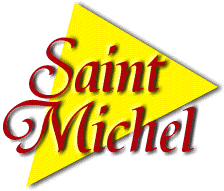Saint-Michel de Dijon is a sizeable church in the late Flamboyant style with a Renaissance screen, not just an elaborate doorway, but forming the whole of the west front. Since the entire front is comprehended within a unified design, the adherence to medieval form is all the more remarkable. For at Saint-Michel there is a triple portail such as would have been built on any thirteenth-century cathedral in France.

Work on the west front began in 1529. The sculptures were probably the work of Jean Damotte, who certainly carved the Retable des TrespassÚs inside the church. Two angels of his have survived in the south transept and are very similar to those of the porch. The south arch of the porch bears the date I537 and the central arch 1551. The Last Judgement in this is by Nicholas de la Cour. He came from Drouai, but the inspiration is obviously Florentine. But it is not just in the style that these decorations announce the arrival of the Renaissance ; it is in the subject-matter also. The long frieze which surmounts the portail and separates it from the fašade above is decorated with scrolls and grotesque figures interwoven with texts from the Apocalypse, but at either extremity of the frieze is a bas-relief ; the scenes depicted are from the Labours of Hercules.
 |
 |
The
three cavernous recesses, corresponding respectively with the nave and
its aisles, present to the visitor a perspective of diminishing arches,
their imposts and architraves offering the usual series of statues and
carvings in the truest Gothic tradition. But the style of the decoration
is pure Renaissance. The fašades of the towers are composed of pillars,
pilasters and pediments, the four storeys divided by the correctest of
cornices and the entablatures carved with curling acanthus scrolls.
 |
|
In the centre of the porch, on the pier between the double doors, is a statue of St Michael. The console which supports him is covered with carvings which show the saine mixture of sacred and secular subjects. David slaying Goliath, the Judgement of Solomon, John the Baptist preaching in the wilderness, Christ appearing to Mary Magdalene are represented together with Leda and her swan, Cupid at the toilet of Venus and Hercules carrying off the cattle of the monster Geryon - a strange assortment for the decoration of a Christian temple.
